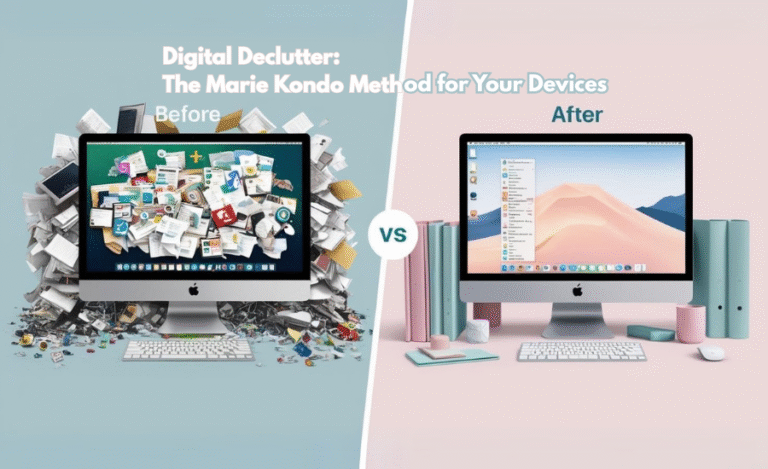
Are you drowning in a sea of digital noise while still feeling somehow disconnected? Do you find yourself endlessly scrolling through apps that leave you feeling empty rather than enriched? Has technology transformed from a useful tool into a demanding taskmaster controlling your attention?
You’re experiencing what researchers now call “digital maximalism” – the state where our devices demand more from us than they provide in return. A recent MIT Technology Review study found that the average person interacts with 4,000+ digital touchpoints daily – a 400% increase from just five years ago. Meanwhile, Microsoft Research reports that our collective digital attention span has decreased from 12 seconds in 2000 to just 8 seconds today – less than that of a goldfish.
As a digital wellness strategist who’s guided thousands through the process of recalibrating their relationship with technology, I’ve developed an approach that doesn’t require abandoning modern life. Digital minimalism isn’t about rejection – it’s about intention. It’s about keeping what serves you and eliminating what doesn’t.
In this comprehensive guide, you’ll discover how to implement digital minimalism principles in 2025’s hyperconnected landscape. You’ll learn practical strategies to harness technology’s benefits while avoiding its pitfalls, all without needing to live in a cabin in the woods or abandon your smartphone. By the end, you’ll have a personalized framework for technology use that enhances rather than diminishes your life quality.
Ready to transform your relationship with technology from passive consumption to purposeful utilization? Let’s begin.
Understanding Digital Maximalism: How We Got Here
The digital landscape of 2025 bears little resemblance to what existed just a decade ago, creating unprecedented challenges for maintaining technological balance.
We’ve unwittingly slipped into an era of digital maximalism – the belief that more connectivity, more features, and more digital engagement inherently improves our lives. This mindset hasn’t emerged by accident; it’s the result of deliberate design choices made by the technology industry combined with fundamental aspects of human psychology.
The attention economy has evolved into an increasingly sophisticated system designed to capture and monetize every moment of your awareness.
Digital anthropologists at Stanford’s Center for Digital Well-being have documented how technology companies employ thousands of engineers specifically tasked with making products as engaging (or addictive) as possible. These efforts leverage sophisticated psychological principles:
- Variable reward mechanisms that create dopamine-driven feedback loops
- Social validation triggers that exploit our need for connection and approval
- Fear of missing out (FOMO) amplification through algorithmic content selection
- Infinite scroll and autoplay features that remove natural stopping points
- Artificial scarcity and urgency cues that trigger stress responses
Consider these striking findings from recent research:
- The average person unlocks their smartphone 150+ times daily – once every 5.5 minutes of waking life
- 76% of productivity app users report feeling more stressed and less productive after adopting these tools
- AI-driven content algorithms now predict user interests with 91% accuracy, creating increasingly persuasive engagement hooks
- The newest generation of social and productivity applications uses over 47 distinct psychological triggers to maintain user engagement
This immersive digital environment isn’t just changing our behaviors – it’s reshaping our cognitive architecture.
Neuroimaging studies from UCLA’s Brain Mapping Center reveal that heavy digital media users show structural brain changes in regions associated with attention, emotional processing, and impulse control. These patterns resemble those seen in other behavioral dependencies.
Why Digital Minimalism Now?
The convergence of several technological trends has created a perfect storm necessitating a minimalist response:
- Ambient Computing: With smart homes, wearables, and IoT devices, technology now surrounds us constantly rather than being accessed intentionally.
- AI Integration: Increasingly sophisticated AI has made digital tools more personalized and predictive – and thus more compelling and harder to disengage from.
- Reality Blending: AR glasses, immersive VR, and spatial computing have blurred the lines between digital and physical experiences.
- Attention Fragmentation: Work, entertainment, shopping, and social connection increasingly flow through the same devices, eliminating natural boundaries.
Digital minimalism offers a philosophical and practical response to these challenges – not by rejecting technology, but by reclaiming agency over how we engage with it.
Warning Signs: Is Digital Maximalism Degrading Your Life Quality?
How do you know if your relationship with technology has become unbalanced? Look for these revealing indicators:
- Reflexive Checking: You reach for your device without conscious intention, often within minutes of the last check
- Phantom Vibration Syndrome: You experience false sensations of device notifications even when none occurred
- Digital Amnesia: You struggle to remember information you’ve consumed digitally or conversations you’ve had online
- App Overwhelm: Your devices contain dozens of applications you rarely use but feel unable to delete
- Validation Seeking: You feel genuine anxiety if digital content you share doesn’t receive prompt engagement
- Comparison Distress: Time on social platforms regularly leaves you feeling inadequate rather than connected
- Subscription Creep: You’re paying for multiple digital services you rarely use or enjoy
- Digital Leashing: You feel genuine anxiety when separated from your devices, even briefly
- Recursive Browsing: You find yourself opening the same apps repeatedly in a loop despite just checking them
- Attention Erosion: You struggle to engage in activities requiring sustained focus (reading books, deep conversations)
- Reality Displacement: You instinctively document experiences for digital sharing rather than fully experiencing them
- Displaced Time Awareness: You’re frequently shocked by how much time has passed during digital engagement
How many of these patterns do you recognize in your own life? If four or more resonate with you, implementing digital minimalism principles could significantly enhance your wellbeing.
Preparation: Creating the Foundation for Digital Minimalism
Successfully implementing digital minimalism requires thoughtful preparation rather than impulsive purging.
The transition to digital minimalism isn’t about making dramatic declarations or deleting all your apps in a moment of frustration. Instead, it requires creating an intentional foundation that will support lasting change in your relationship with technology.
This preparation phase is essential because it replaces reactive digital habits with proactive technology strategies.
Research from the University of California’s Center for Digital Behavior found that individuals who engaged in structured preparation before implementing digital changes were 3.7 times more likely to maintain those changes after six months compared to those who attempted “cold turkey” approaches.
A large-scale study published in the Journal of Behavioral Science showed that properly prepared digital minimalists experienced 52% greater life satisfaction improvements while still maintaining professional productivity and social connection.
Follow these steps to establish your digital minimalism foundation:
Clarify Your Digital Values
Begin by articulating what you actually want from technology:
- Identify the core functions that genuinely enhance your life and work
- Define what “enough” looks like in each digital category
- Distinguish between uses that serve you versus those that serve platform interests
- Create a personal mission statement for technology use that aligns with your broader life values
Conduct a Digital Inventory
Document your current digital landscape:
- List all devices, apps, platforms, subscriptions, and digital services
- Track actual usage patterns for one week (screen time analytics can help)
- Categorize each digital tool as essential, supportive, or distracting
- Calculate the total financial cost of your digital footprint
- Identify redundancies and overlaps in your digital tools
Design Your Minimalist Digital Architecture
Create the structure for your intentional digital life:
- Select the minimum viable technology for each legitimate need
- Identify primary and backup tools for essential functions
- Design digital boundaries (time limits, access restrictions, notification protocols)
- Create designated spaces and times for different types of digital engagement
- Establish clear separation between professional and personal digital tools
Prepare Your Environment
Modify your physical and digital spaces to support minimalism:
- Designate specific locations for device usage and charging
- Create analog alternatives for key functions (paper notebooks, alarm clocks)
- Install digital minimalism tools (blockers, timers, monotasking apps)
- Configure existing devices for minimal distraction (grayscale, notification settings)
- Remove temptation triggers from your physical environment
The final preparation step is communicating your intentions to relevant people in your life.
For family members, this might involve establishing shared technology guidelines. For colleagues, it could mean setting new digital communication expectations. The key is framing your changes positively – not as a rejection of connection, but as a way to be more present and effective in your important relationships.
Remember: The time invested in preparation directly correlates with sustainable success in digital minimalism.
The 4-Week Digital Minimalism Challenge Blueprint
This progressive four-week plan will systematically transform your relationship with technology through manageable weekly objectives.
Each week builds upon the previous one, allowing you to gradually recalibrate your digital habits while maintaining necessary connectivity. Follow this structured approach for optimal results.
Week 1: Digital Decluttering & Awareness
Objectives:
- Eliminate digital excess across all devices and platforms
- Establish baseline awareness of unconscious digital habits
- Create initial boundaries around technology use
Daily Actions:
- Morning Intention Setting: Begin each day by writing one non-digital priority before touching devices
- Digital Detox Sessions: Implement three 2-hour periods completely free from discretionary technology
- App Assessment: Review and remove 5 unnecessary apps daily (35 total this week)
- Notification Audit: Disable all notifications except from essential human contacts
- Single-Tasking Practice: Use only one digital application at a time, closing others completely
What to Expect: The first week typically brings heightened awareness of just how frequently you reach for devices. You may experience attention discomfort – the mental equivalent of phantom limb syndrome as your brain adjusts to reduced digital stimulation. Some social FOMO is normal, alongside initial productivity anxiety.
Tips for Success:
- Use physical barriers to create friction (store devices in drawers between intentional use)
- Set a timer during necessary digital sessions to maintain awareness
- Create a “digital distraction log” noting when, why, and how you feel compelled to check devices
- Replace common digital defaults with analog alternatives (paper grocery lists, physical books)
Week 2: Values-Based Digital Recalibration
Objectives:
- Align remaining technology with your core values and purposes
- Establish focused time blocks for different types of digital engagement
- Implement mindful usage practices for essential technologies
Daily Actions:
- Values Assessment: Evaluate one digital platform daily against your personal values statement
- Digital Timeboxing: Contain all non-essential digital activities within two 30-minute blocks
- Mindful Engagement Practice: Before opening any app, pause and articulate your specific purpose
- Platform Purge: Unfollow/unsubscribe from 10 low-value content sources daily
- Digital Replacement: Substitute one typically digital activity with a physical alternative each day
What to Expect: By week two, initial discomfort begins transitioning to moments of unexpected clarity and presence. Many participants report improved sleep quality and reduced anxiety. You’ll become increasingly aware of manipulative design elements in your remaining digital tools, which may produce a combination of irritation and empowerment.
Tips for Success:
- Create environmental cues that support your new habits (visual reminders, dedicated spaces)
- Experiment with analog productivity systems (bullet journaling, time blocking)
- Share your experience with one supportive person who can provide accountability
- Allow yourself to feel the discomfort of reduced digital stimulation without immediately seeking relief
Week 3: Relationship & Communication Recalibration
Objectives:
- Transform digital relationships into more meaningful connections
- Establish sustainable communication protocols
- Create clear boundaries between connective and consumptive technology
Daily Actions:
- Conversion Experiment: Convert one digital interaction into a voice or in-person exchange
- Communication Consolidation: Check personal digital messages at only 2 scheduled times
- Digital Circle Audit: Evaluate one relationship sphere daily (work, family, friends, interest groups)
- Depth Challenge: Have one conversation daily that would normally occur through text/messaging
- Digital-to-Physical Bridge: Schedule one in-person activity with someone you primarily interact with online
What to Expect: Week three often brings relational insights as you distinguish between authentic connections and digital performance. Some relationships may feel temporarily strained as you shift engagement patterns. Many participants report deeper conversations and surprising positive reactions from others who share similar digital fatigue.
Tips for Success:
- Create clear expectations for response times with important contacts
- Develop templates for common digital communications to reduce time spent
- Practice transitioning conversations from digital to analog when depth is needed
- Remember that availability and attentiveness are different qualities
Week 4: Digital Minimalism Lifestyle Integration
Objectives:
- Develop personal principles for ongoing technology decisions
- Create systems that maintain digital minimalism without constant effort
- Build resilience against inevitable digital pressure
Daily Actions:
- Decision Framework: Create personal policies for common digital scenarios (new app installations, social platform invites)
- Technology Review: Assess one digital life area daily (work, entertainment, communication, creation, consumption)
- Maintenance System: Establish regular “digital reset” protocols (daily, weekly, monthly)
- Values Alignment: Conduct a comprehensive review of all remaining digital tools against your values
- Future-Proofing: Identify potential upcoming digital challenges and pre-emptively create minimalist responses
What to Expect: The final week brings integration of your new digital awareness into a cohesive lifestyle approach. You’ll likely notice increased sensitivity to digital overload when it occurs. Many participants report a sense of agency and intentionality that extends beyond technology into other life areas.
Tips for Success:
- Document your personal digital minimalism philosophy for future reference
- Create environmental defaults that support continued minimalism
- Identify and connect with like-minded individuals for ongoing support
- Recognize that digital minimalism is an evolving practice rather than a fixed destination
Post-Challenge Integration: Sustainable Digital Minimalism in a Maximum World
The true test of digital minimalism comes in maintaining intentionality within a digital ecosystem designed for maximalism.
While the structured 4-week challenge provides a framework for initial transformation, sustaining digital minimalism requires integrating these principles into your ongoing lifestyle. This isn’t about rigid rules but about creating sustainable systems that support continued intentionality.
Successful digital minimalists don’t rely on perpetual willpower but on intelligent design of their digital environments.
Research from the Technology Ethics Center at Georgetown University found that individuals who implemented structured “digital architecture” maintained 78% of their initial improvements after one year, compared to just 16% for those relying on willpower alone.
A longitudinal study of digital behaviors revealed that minimalists who established regular review practices were able to resist an average of 67% of new digital distractions that emerged over time.
Implement these strategies to maintain your digital minimalism in 2025’s hyperconnected landscape:
Intention Architecture
Create persistent systems that embed intentionality into your digital life:
- Establish a quarterly “digital life review” to assess alignment with values
- Implement a 48-hour waiting period for adding any new digital tools
- Create a “digital nutritional label” template to evaluate new technologies
- Design default settings on all devices to minimize distraction
- Maintain separate devices or profiles for different life contexts when possible
Attention Sanctuaries
Designate protected spaces free from digital maximalism:
- Maintain completely technology-free zones in your home
- Establish daily “digital sabbath” periods (minimum 2 hours)
- Create weekly extended offline periods (4+ hours)
- Design social gatherings with explicit technology expectations
- Designate certain activities as permanently technology-free
Content Curation
Take control of what enters your digital awareness:
- Use RSS readers instead of algorithm-driven content discovery
- Implement aggressive filtering on all information channels
- Curate digital relationships based on quality rather than quantity
- Schedule batch consumption of news rather than constant updates
- Separate creation tools from consumption platforms
Relationship Protocols
Establish clear expectations for digital communication:
- Create personal communication tiers with different response expectations
- Develop templates for common digital interactions to reduce time spent
- Implement “slow communication” periods for deeper digital exchanges
- Establish clear boundaries between work and personal digital communication
- Regularly convert digital relationships to richer interaction formats
The ultimate goal of digital minimalism isn’t technological asceticism but meaningful technological alignment.
As Cambridge tech ethicist Dr. Eliza Montgomery notes, “Digital minimalism isn’t about using less technology—it’s about using technology less unconsciously.” The key is regular recalibration as both technology and your needs evolve.
Remember to adapt your digital minimalism practice across different life seasons. Create specific protocols for:
- High-intensity work periods
- Vacation and recovery time
- Social connection phases
- Learning and growth periods
- Creative production times
“In a world optimized for consumption, the most radical act is intentional use.”
Modeling Digital Minimalism: Influencing Your Circles Without Preaching
Your digital minimalism practice has the potential to positively influence others through demonstration rather than evangelism.
As you implement these principles, you’ll likely notice others expressing curiosity about your changed relationship with technology. This creates natural opportunities to share digital minimalism concepts without imposing your choices on others.
Research consistently shows that social diffusion of behavior change is more effective through modeling than through direct persuasion.
A study from NYU’s Media Psychology Lab found that individuals who observed digital minimalism practiced by respected peers were 3.4 times more likely to adopt similar practices compared to those who received direct recommendations or educational information.
Evidence from organizational psychology suggests that visual demonstration of alternative digital behaviors creates “permission structures” that counteract maximalist defaults.
Consider these approaches to mindfully expanding your influence:
Family Implementation
- Create collaborative technology agreements rather than unilateral rules
- Design family-specific minimalist practices (device-free meals, tech-free activities)
- Implement age-appropriate digital literacy conversations
- Recognize different family members may need different digital boundaries
- Focus on the positive benefits rather than demonizing technology
Social Circle Expansion
- Initiate non-digital activities that create space for deeper connection
- Respect others’ digital choices while clearly communicating your own
- Share personal benefits observed rather than prescribing practices
- Create social environments that naturally minimize digital distraction
- Express appreciation when others respect your digital boundaries
Workplace Influence
- Demonstrate improved productivity through minimalist practices
- Propose specific digital wellness enhancements for team consideration
- Share relevant research connecting digital minimalism to business outcomes
- Create opt-in experiments for interested colleagues
- Model sustainable digital communication without demanding it from others
Community Building
- Connect with like-minded individuals seeking digital balance
- Create physical spaces that encourage digital minimalism
- Share resources without judgment or pressure
- Highlight diverse approaches to digital intentionality
- Recognize that digital minimalism looks different across cultures and contexts
Remember that your most powerful influence comes through consistent practice rather than perfect adherence.
When others observe your increased presence, improved focus, and enhanced wellbeing, they naturally become curious about your methods. Be prepared to share your experience authentically—including challenges and setbacks—when invited to do so.
“Digital minimalism spreads through curiosity, not conversion.”
Troubleshooting: Navigating Common Digital Minimalism Challenges
Even committed digital minimalists face obstacles maintaining their practice. Here are solutions to the most common challenges:
Challenge: Social and Professional FOMO
Solution:
- Distinguish between actual missing out and fear of missing out
- Create selective digital “listening posts” that capture truly important information
- Develop criteria for what constitutes “need to know” versus “nice to know”
- Implement information digests that consolidate essential updates
- Schedule regular check-ins with key information sources rather than constant monitoring
- Remember that truly important information typically reaches you through multiple channels
Challenge: Digital Environment Resistance
Solution:
- Frame digital minimalism as a productivity enhancement rather than a philosophical stance
- Create bounded exceptions for truly necessary maximalist environments
- Develop transitional practices when moving between minimalist and maximalist contexts
- Use technological solutions (separate devices, profiles, or accounts) to create boundaries
- Identify allies in resistant environments who share your concerns
- Focus influence efforts on your immediate sphere of control
Challenge: New Technology Integration
Solution:
- Develop a personal evaluation framework for new technologies (value alignment, attention cost, benefit analysis)
- Implement a waiting period before adopting new digital tools
- Seek minimalist configurations for necessary new technologies
- Consider privacy and attention implications before adoption
- Research how others have integrated similar technologies into minimalist practices
- Remember that initial settings and usage patterns often become defaults—choose carefully
Challenge: Digital Identity Dependencies
Solution:
- Distinguish between digital identity and authentic self-expression
- Gradually migrate identity expression to more meaningful platforms
- Schedule specific times for identity maintenance activities
- Develop metrics for meaningful engagement versus performative sharing
- Create alternative identity expression in physical contexts
- Recognize that digital identity curation often creates more anxiety than satisfaction
Challenge: Relapse Into Maximalist Patterns
Solution:
- Identify specific trigger situations that lead to maximalist behaviors
- Create environmental modifications to interrupt unconscious digital habits
- Implement a “digital reset” protocol for recovery after immersive digital periods
- Track patterns to identify vulnerability factors (stress, isolation, boredom)
- Develop non-judgmental awareness of maximalist tendencies rather than harsh self-criticism
- Establish regular check-in practices with accountability partners
- Remember that digital minimalism is a continual practice, not a permanent state
When to Seek Additional Support
If your relationship with technology is significantly impacting your wellbeing, relationships, or functioning despite consistent effort, consider these resources:
- Digital wellness coaches specializing in minimalist practices
- Cognitive-behavioral therapists familiar with behavioral dependencies
- Community support groups focused on intentional technology use
- Workplace digital wellness programs (increasingly common in 2025)
- Digital mindfulness retreats or workshops for immersive reset experiences
Remember that seeking support indicates wisdom rather than weakness in navigating our complex digital landscape.
The Digitally Mindful Life: Your New Relationship With Technology
Congratulations on exploring this comprehensive guide to digital minimalism. By implementing these strategies, you’re joining a growing movement of individuals reclaiming agency in their technological lives – not by rejecting the digital world, but by engaging with it mindfully and intentionally.
The benefits of digital minimalism extend far beyond reduced screen time:
- Enhanced cognitive capacity through decreased attention fragmentation
- Deeper and more meaningful relationships both online and offline
- Improved ability to distinguish valuable information from digital noise
- Greater alignment between personal values and technological tools
- Increased creative output and original thinking
- Reduced anxiety, comparison, and digital overwhelm
The individuals who thrive in our hyperconnected future won’t be those who adopt every new technology or completely reject digital life, but those who thoughtfully curate their digital environment to serve their authentic needs and values.
Take action today:
- Download our free Digital Minimalism Starter Kit
- Select your challenge start date within the next week
- Identify your first three digital minimalist practices to implement
- Share your intention with one supportive person
“In a world designed to capture your attention, choosing where to place it is your most powerful act.”
Frequently Asked Questions
Won’t digital minimalism hurt my career in an increasingly digital workplace?
This common concern reflects a fundamental misconception about digital minimalism. The approach isn’t about using less technology, but about using technology with greater intention and effectiveness. In fact, research from Harvard Business Review found that professionals practicing digital minimalism reported 31% higher productivity and 22% better work satisfaction. The key distinction is between being digitally available and digitally effective. By eliminating low-value digital noise, you actually enhance your capacity for high-value digital work. Many minimalists find they develop valuable technological discernment that becomes a career advantage in environments suffering from digital overwhelm.
How can I practice digital minimalism when my family/friends are constantly online?
Navigating relationship dynamics is indeed one of the greatest challenges in digital minimalism. Start by clearly communicating that your changes aren’t a judgment of others’ choices but a personal experiment in wellbeing. Establish specific times when you’re fully digitally available to important people, while protecting other periods for minimalist practice. Create alternative connection opportunities that don’t rely on constant digital engagement. Most importantly, demonstrate through your presence and engagement that digital minimalism enhances rather than diminishes your relationships. Many practitioners find that their closest connections actually appreciate their increased attentiveness, even if initial adjustments require patience.
I’ve tried reducing my technology use before and always end up back where I started. What makes this approach different?
Traditional “digital detox” approaches typically fail because they rely on willpower rather than redesigning your relationship with technology. Digital minimalism succeeds through comprehensive system design: clarifying values, modifying environments, establishing protocols, and creating sustainable habits. The structured 4-week challenge provides progressive skill building rather than abrupt withdrawal. Additionally, digital minimalism addresses the underlying psychological needs that technology serves, ensuring those needs are met through more satisfying alternatives. The approach recognizes that consistency matters more than perfection, building resilience against inevitable setbacks. Most importantly, digital minimalism evolves alongside technology rather than attempting to establish rigid rules in a changing digital landscape.
What about essential digital tools I need for work and life management?
Digital minimalism distinguishes between necessary digital tools and unconscious digital consumption. The approach doesn’t advocate eliminating essential technology but optimizing how you engage with it. This might mean batching essential digital tasks, configuring tools for minimal distraction, or establishing clear boundaries between different types of digital use. Many practitioners find that separating essential tools into dedicated devices or user profiles significantly reduces digital spillover. The key is recognizing that most digital overwhelm comes not from necessary tools but from the endless expansion of digital usage beyond core functions. Digital minimalism helps you maintain the former while eliminating the latter.
Will I miss important cultural touchpoints or social connections by reducing my digital presence?
This question reveals one of the most powerful psychological hooks of digital maximalism: the suggestion that reduced engagement means missing something essential. In reality, truly important information and connections have remarkable persistence – they reach you through multiple channels and opportunities. Digital minimalists often discover that by curating fewer, more meaningful information sources, they actually develop deeper cultural awareness than those passively consuming algorithmic feeds. The approach emphasizes quality over quantity in both information and relationships. Many practitioners report feeling more genuinely connected to important cultural conversations by stepping back from the constant churn of digital reaction to engage more thoughtfully with fewer, more significant touchpoints.
Transform the concepts from this guide into immediate action with our comprehensive implementation toolkit. This downloadable resource includes:
- Digital Values Assessment Worksheet
- 30-Day Challenge Calendar with Daily Actions
- Technology Inventory & Evaluation Templates
- Communication Scripts for Setting Digital Boundaries
- Troubleshooting Guide for Common Challenges
- Reflection Journal for Tracking Your Progress






